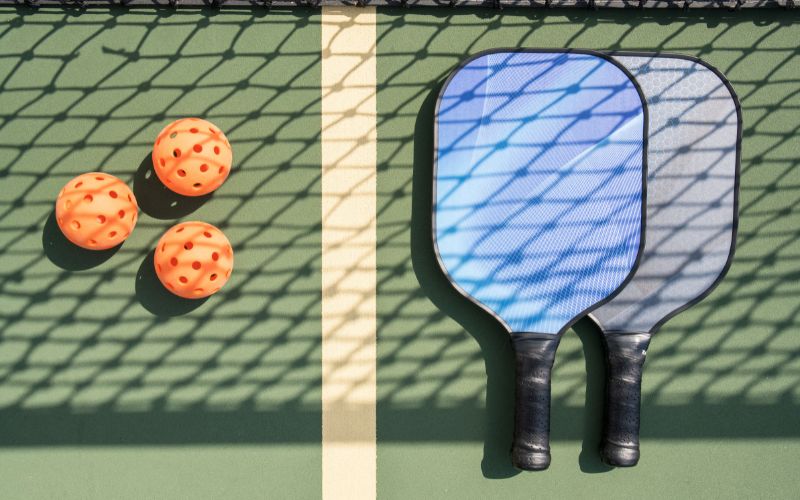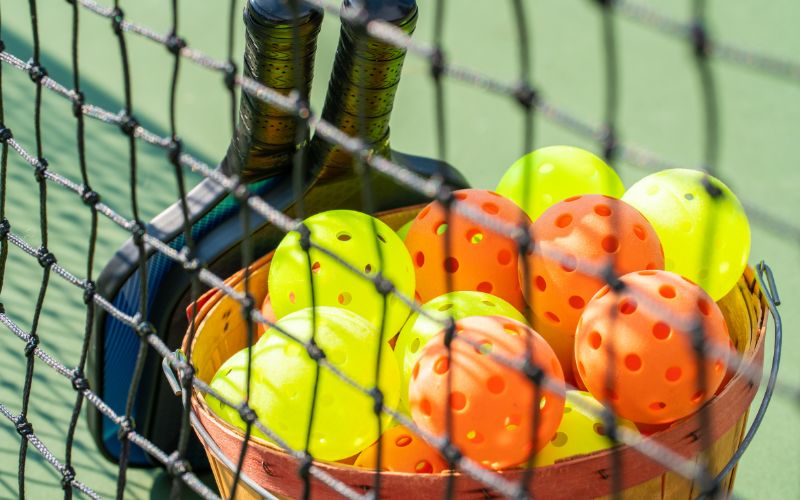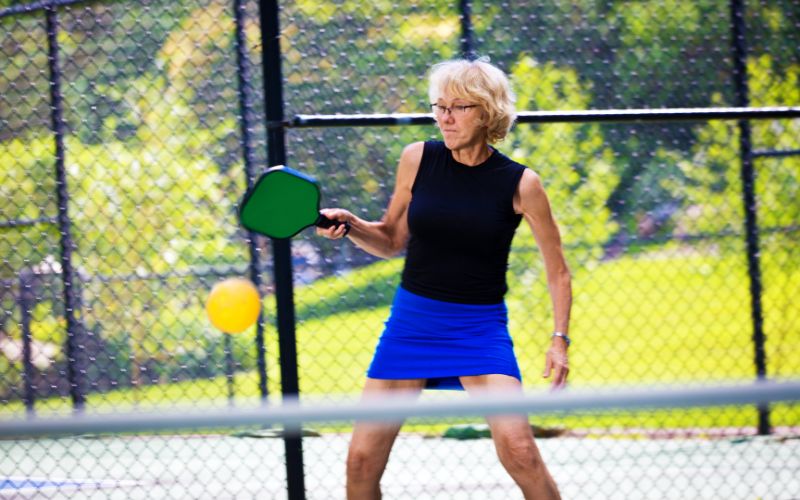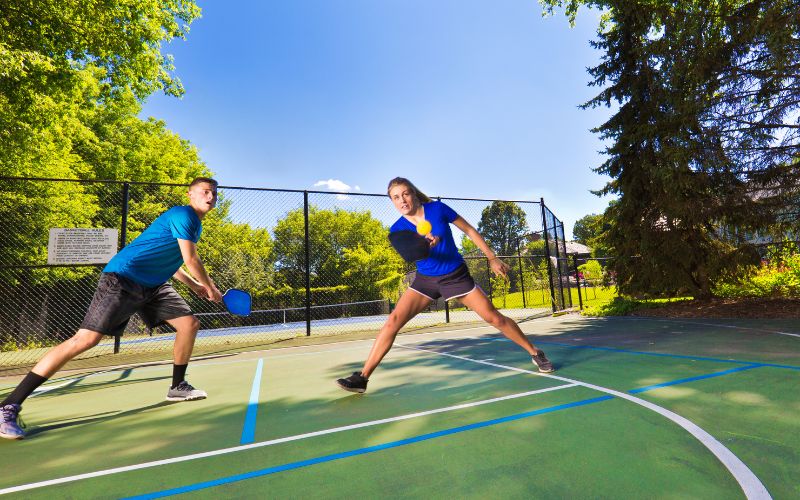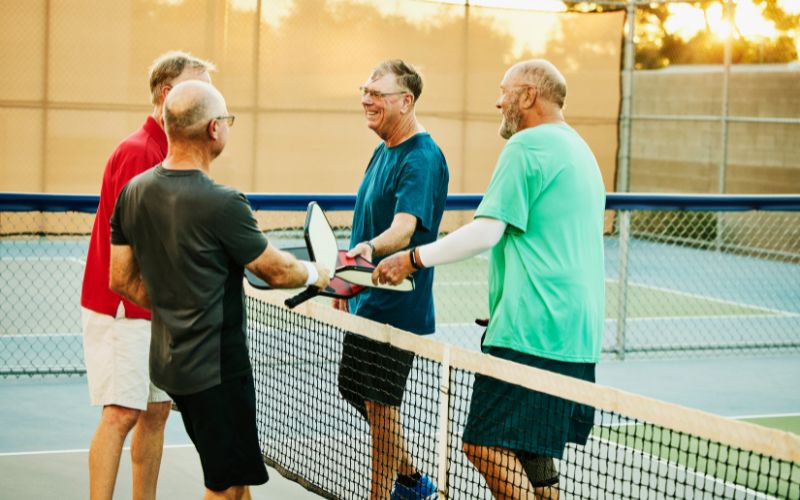Pickleball is a paddle sport that combines elements of badminton, tennis, and table tennis. It has rapidly gained popularity due to its accessibility and fun, social nature. This guide will introduce you to the pickleball basics, from understanding the equipment and rules to developing fundamental skills.
Understanding Pickleball
What is Pickleball?
Pickleball is a sport played on a court with a net stretched across the center, similar to tennis. Players use solid paddles made of wood or composite materials to hit a perforated polymer ball, similar to a wiffle ball, over the net.
The Pickleball Court
The pickleball court is a rectangle with dimensions 20 feet wide by 44 feet long for both singles and doubles. The net height is 36 inches at the sidelines and 34 inches in the middle. The court is striped similarly to a tennis court with left and right service squares and a 7-foot non-volley zone in front of the net (commonly referred to as the “kitchen”).
The Equipment
Pickleball Paddle
When playing pickleball games, pickleball paddles are the primary tool used by players to hit the ball. They are smaller than tennis rackets but larger than ping-pong paddles. Paddle heads have evolved from simple wooden designs to sophisticated materials that enhance performance. Modern paddles are typically made from lightweight composite materials such as graphite or fiberglass, which offer a good balance between power and control. They have a flat surface without strings and come in various shapes and sizes to suit different playing styles.
Balls
Pickleball itself is unique to the sport. It’s similar to a wiffle ball, made of durable plastic with holes through it. There are two main types of pickleball balls: indoor and outdoor. Indoor balls are softer and have larger holes, which makes them less affected by the indoor environment. Outdoor balls are made to withstand rougher surfaces and are heavier and harder, with smaller holes to mitigate the effects of wind.
Net
The net in pickleball is similar to a tennis net but is slightly lower. The official pickleball net height is 36 inches at the sidelines and 34 inches at the center. Portable net systems are popular in pickleball, allowing players to set up a game on any flat surface.
Court
The pickleball court is a flat, rectangular surface measuring 20 feet in width and 44 feet in length. It’s divided into two sides by the net. Each side has left and right service courts and a 7-foot non-volley zone, also known as “the kitchen,” extending from the net. Courts can be made of various materials, including concrete, asphalt, and specialized modular surfaces.
Shoes
While not unique to pickleball, proper footwear is essential. Players often wear court shoes that provide good lateral support to handle the quick side-to-side movements required in the game. The soles should offer grip to prevent slipping and be non-marking to protect the court surface.
Clothing
Pickleball clothing is typically lightweight and breathable athletic wear that allows for a full range of motion. Players often wear shorts, skirts, or athletic pants paired with moisture-wicking shirts.
Accessories
Players may also use various accessories, such as:
- Gloves: Some players wear gloves to improve grip and prevent blisters.
- Sweatbands: Worn on the wrist or head to help manage sweat.
- Eyewear: Protective eyewear is sometimes used to shield the eyes from both the sun and the ball.
- Bags: Specialized pickleball bags are available to carry paddles, balls, and personal items.
Basic Pickleball Rules
Serving
- The very first serve must be made underhand.
- Paddle contact with the ball must be below the waist level.
- The serve is made diagonally crosscourt and must land within the confines of the opposite diagonal court.
- Both feet must be behind the backline when serving.
Scoring
- Games are typically played to 11 points and must be won by 2 score points.
- Points can only be scored by the serving team.
- When the serving team’s score is even, the player who was the first serve in the game for that team will be in the right-hand court; when it is odd, they will be in the left-hand court.
Faults
- Hitting the ball out of bounds.
- Not clearing the net.
- Volleying the ball from the non-volley zone.
- Volleying the ball before the ball bounces once on each side of the net.
The Double-Bounce Rule
After the ball is served, each side must make at least one groundstroke prior to volleying the ball (hitting it out of the air).
Playing the Game
The Serve
- One of the basic rules is the serve in pickleball is executed underhand and must be hit below the waist.
- The server must serve diagonally across the court to the opponent’s service zone.
- The serve must clear the non-volley zone, including the line (known as the kitchen line).
- If the serving team loses the point, the server switches sides and continues serving from the other side of the court. This continues until they lose a point again, at which point the serve goes to the opponent.
- The only exception to this rule is at the start of a new game where the first serving team is only allowed one fault before the serve goes to the opponents.
Volleys
- A volley is hitting the ball out of the air before it bounces.
- Players must avoid volleys in the non-volley zone (the kitchen) unless the ball bounces there.
- Volleys are strategic shots used to keep the opponent off balance and to gain offensive advantage.
Dinks
- A dink is a soft shot that is intended to fall into the opponent’s non-volley zone.
- Dinks are a crucial part of the strategy, often used to outmaneuver opponents and create openings.
- Effective dinking requires control and finesse, as the goal is to make it difficult for the other team to return with a volley.
Groundstrokes
- Groundstrokes are hits after the ball has bounced once on the court.
- These can be either forehand or backhand strokes.
- Groundstrokes are used to maintain the rally and to set up offensive plays.
Lobs
- A lob is a shot that sends the ball high over the opponent’s head, ideally landing close to the baseline.
- Lobs can be used defensively to give time to reposition or offensively to catch the opposing team off guard.
- However, if not executed properly, lobs can be easily slammed back by the opponent.
Slams
Slams or smashes are aggressive overhead shots aimed at ending the point.
These are typically used when the ball is high enough in the air to be struck forcefully downwards into the opponent’s court.
Slams are high-risk but high-reward shots that can be game-changers when used appropriately.
In tournament games, these components of play are executed with precision and strategy. The serving team aims to maintain control of the serve for as long as possible because only the serving team can score points.
The receiving team focuses on defense and on creating opportunities to regain the serve. The server continues serving until their team loses a rally, at which point the serve passes to the opposing team. The game continues with this back-and-forth until one team reaches the predetermined number of points to win the game, typically 11 or 15, and must be ahead by at least 2 points.
Pickleball Strategy and Tips
Strategies and tips are essential for players who want to improve their game and enjoy the sport more fully. Whether you’re just starting out or looking to refine your skills, understanding the strategic elements of pickleball can enhance your performance on the court. Here are some strategies and tips to consider:
Serve Strategies
- Drop Serve: Recently approved by USA Pickleball, the drop serve allows for a more relaxed service motion. The server lets the ball drop to the ground and hits it after one bounce. This can be an effective serve for those who struggle with the traditional serve.
- Server Serves Deep: When the server aiming deep into the opponent’s court, behind the baseline, can push them back and open up the court.
- Server Loses Advantage: Remember, if the server loses the rally, the serve goes to the opponent’s team. In doubles, the serve will switch to the second server on the same team before it goes to the opponents.
Double Strategies
- First Server: In doubles play, the first server has a unique position. After the first server loses the serve, the second server serves from the same side. This is unlike tennis, where the server switches sides for each point.
- Second Server: It’s a signal to the team that they need to be ready to switch to a defensive strategy once the serve is lost.
Court Positioning
- Stay Behind the Baseline: After serving, quickly move to a position behind the baseline. This is a fundamental part of the strategy, as it allows you to cover the court effectively.
- Move as a Team: In doubles, it’s crucial to move in tandem with your partner, maintaining a consistent distance between you to cover the court effectively.
Rallying Tips
- Pickleball Essentials: Use wooden paddles or composite ones to control the ball better. The type of paddle can significantly affect your play.
- Fair Method: Always play with a strategy in mind. Whether it’s keeping the ball away from your opponent’s strong side or targeting their weaknesses, a fair method is about using strategy, not power.
- Wait for the Right Moment: Be patient during rallies. Wait for the right moment when your opponent hits a weak shot to attack.
General Tips
- Start Playing: Pickleball is a fun sport that’s easy to learn but challenging to master.
- Pickleball Courts: Look for pickleball courts in your area. Many communities have them, and they’re typically a badminton-size court, which is smaller than a tennis court, making the game more accessible.
- Pickleball Journey: Enjoy your journey. As you play more, you’ll learn the nuances of the game and develop your own strategies.
- Unlike Tennis: Remember, pickleball has a unique rule set, and strategies that work in tennis may not always apply. The non-volley zone, or ‘kitchen,’ changes the dynamic of net play significantly.
By incorporating these strategies and tips into your game, you’ll be well on your way to becoming a more skilled pickleball player.
Pickleball for All
Pickleball is a sport for all ages and skill levels. It’s easy to learn but can develop into a quick, fast-paced, competitive game for experienced players.
Pickleball is a fun, social sport that is easy to learn but can be challenging to master. With its simple rules and engaging play, it’s no wonder pickleball is becoming one of the fastest-growing sports in the world.
Frequently Asked Questions
What is the non-volley zone?
The non-volley zone, also known as the kitchen, is the 7-foot area on either side of the net where you cannot volley the ball.
Can I play pickleball with tennis rackets?
No, pickleball requires specific paddles that are smaller than tennis rackets.
Is pickleball a good workout?
Yes, it’s an excellent cardiovascular workout that improves agility, reflexes, and muscle strength.

